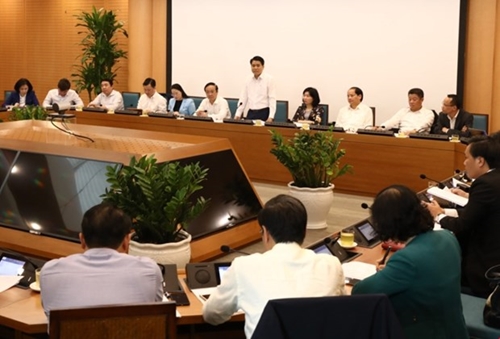Director of the municipal Department of Planning and Investment Nguyen Manh Quyen said the hardest hit sector is tourism as the number of visitors from China, Vietnam’s biggest source, so far has dropped by some 60 percent, followed by Malaysia (34.9 percent), Singapore (19.6 percent), and Thailand (13.4 percent), while that of the domestic tourists has also fallen by 21.2 percent.
Participants at the meeting said if the outbreak is brought under control in the first quarter, the F1 Vietnam Grand Prix could take place as scheduled, as well as other cultural, sporting and festive events. This would help Hanoi’s tourism sector to halt the downward trend in Q2 and rebound from Q3.
In this scenario, the number of tourist arrivals in the city may fall 41.3 percent in Q1 and 10 percent in Q2, but rise 6.4 percent in Q3 and 15.5 percent in the last three months.
    |
 |
|
The meeting of Hanoi authorities on February 26 |
However, they said if the epidemic gets worse and traveler numbers nosedive, revenue collected from tourists this year could fall 8.3 percent to 95.18 trillion VND (4.1 billion USD), equivalent to 81.5 percent of the annual target.
Meanwhile, Quyen noted that production and business activities in February and the first two months of 2020 have been affected by the outbreak, as well as the Government’s Decree 100/2019/ND-CP that regulates fines against administrative violations in road and rail traffic.
Industrial production is forecast to continue growing in Q1 but at a pace slower than in previous years.
FDI businesses from China, the Republic of Korea and Japan, where COVID-19 is raging, are using a large number of managers and experts from their home countries. Restrictions on entry into and exit from Vietnam may lead to a shortage of personnel at their factories, thus adversely affecting production and import and export activities.
Additionally, material supplies are running low and likely to run out at the end of March. In the current context, both domestic and FDI firms working in industries such as animal feed, garments and electronics are likely to experience shortages since most input materials have to be imported, the director added.
If COVID-19 is contained in Q1, it will take companies and factories in China more time to resume operation, he said.
Experts said agricultural production in Hanoi has suffered only a little since the outbreak. However, A/H5N6 has been reported here, and if the avian influenza is not curbed, it will influence animal farming and growth of the agricultural sector.
Admitting the considerable impact of COVID-19 on many sectors, Chairman of the municipal People’s Committee Nguyen Duc Chung said the city has also realized certain opportunities, adding that the epidemic is also a driving force for businesses to seek new markets and modernize technology.
The most important solution now is to boost communications to raise public awareness and prevent the disease from spreading. Besides, it is necessary to push ahead with administrative reforms, business climate improvement, and investment promotion, he noted, asking each agency and sector to issue both short- and long-term solutions to foster economic development.
Source: VNA